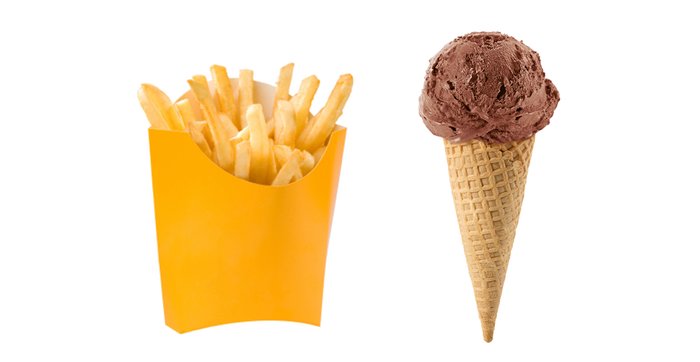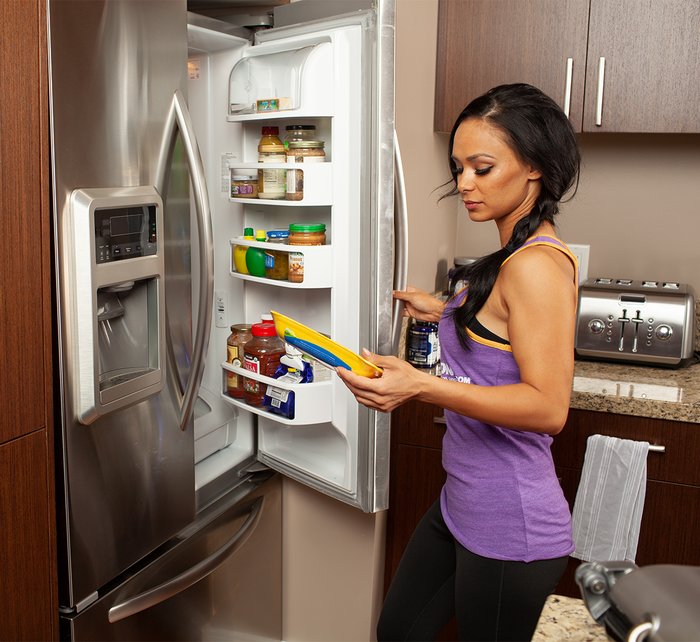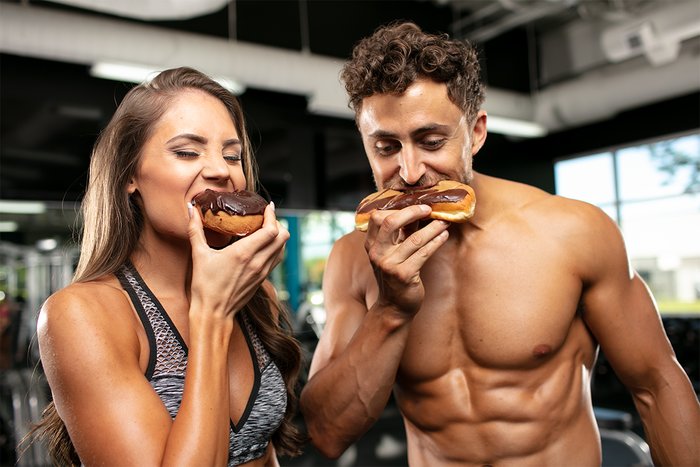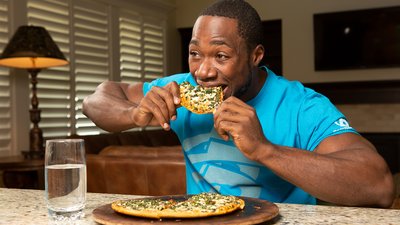Foods that combine high levels of fats and carbohydrates or sugar can seem like a match made in heaven. They taste so good that it's easy to overlook that there are actually very few examples in nature of foods that combine these two nutrients.
For tens of thousands of years, our ancestors got their fats and carbs from separate places: fats from meat and seeds, and carbs from grasses, aquatic plants, leaves, stems, and berries.[1] It was pretty unusual for early humans to combine these foods in a single meal. As early farming developed, humans began combining foods, such as starchy grains and fatty milk products.
Then, in the last century and a half or so, foods combining fats and carbs into one meal have become the norm for many of us: Pizza, ice cream, nutty candy bars, pastries—they're all high in both fats and sugar. But 150 years is the blink of an eye in terms of human evolution, and our bodies still don't really know what to make of this newfangled nutrient combo.
According to a new study, it is our bodies' unfamiliarity with these combo foods that has contributed to the global epidemic of obesity. It has also left millions of people feeling powerless in the face of food choices. Now we know more about why.
What Makes Us Choose the Foods We Eat?
In a study published in the journal Cell Metabolism, researchers carefully explored the way the human brain reacts to foods that combine fats and carbohydrates.[2] They did it by setting up a sophisticated system in which human volunteers chose between, or "bid on," images of different foods. Some of the foods contained only fats, some only carbs, and some a combination of the two.
As the participants made their choices, the researchers used brain-scanning technology to see which parts of their brains were the most active. Invariably, the volunteers chose or bid the most money on the combo foods.

The research team theorized that the choice had something to do with a reward system in the brain that releases the most pleasure-causing dopamine in response to foods with the greatest energy density.
Sounds pretty straightforward: Given a choice of foods, we humans will pick the one that will give us the most life-sustaining energy. But it's more complicated than that.
Are You Reading Your "Post-Ingestive Signals"?
Believe it or not, our bodies are actually pretty good at estimating the energy density of a purely fatty food once we've eaten it. These "post-ingestive signals" are critical for telling us how much of any particular kind of food we need to eat to consume all the calories we need for daily life. When we're full, this is how we know.
But for some reason, we're much less able to make the same calorie estimation after we've eaten a carbohydrate-rich food, or a food that contains a combination of both fats and carbs.
Some of these "after eating" signals go from the gut to the brain and cause the release of dopamine, a neurotransmitter that helps regulate the brain's reward and pleasure centers. The researchers suggest that different gut-to-brain pathways evolved for our diets: one for fats, and a different one for carbohydrates.
The researchers suggest that the way our brains have evolved, these two different pathways have led to two different parts of the brain releasing dopamine. One gives us a dose when we eat—actually, when we even think about eating—a fatty food. An entirely different part of the brain rewards us for picking carbohydrates.
Here's the catch: When we are given the choice of a food that contains both, the brain really doesn't know what to do, and ends up releasing a lot more dopamine than it would for either nutrient alone. And, spoiler alert, when we get rewarded for something, we tend to do more of it.
In fact, according to the study, getting rewarded with this much dopamine turns the act of choosing fat-plus-carb foods into less a matter of choice, and more a matter of addiction.
Getting Bad Brain Feedback About Bad Food
Researchers often use rats or mice in tests before they begin testing with humans. The researchers in this study note that rats are very good at regulating how many calories they consume when they are fed foods that contain either fat or carbohydrates. Give them foods that contain both, though, and this ability to regulate how much to eat breaks down. As a result, the rats quickly gain weight.
Humans appear to do exactly the same thing. Our brain, unclear as to how to reward us for choosing these combination foods, simply rewards us handsomely. We like the reward, so we repeat the action—and gain weight in the process.

That may not have had a huge effect when we were eating a serving of grains, milk, and honey that contains about 1 gram of fat and 27 grams of carbs. Put a tray of donuts in front of us, though, each with 11 grams of fat and 17 grams of carbs, and it's easy to see how our brains have almost become wired to help us gain weight.
In the test itself, the study participants based their choices on images of food, not the food itself. By combining data about the images the participants chose with data about the activity within each participant's brain as they made their choices, the researchers gained insight into what drove the choices.
A Tasty, But Vicious, Cycle
In modern society, there is a tremendous variety of food available to us. If our brains are not very good at estimating how many calories we'll get from foods that combine fats and carbohydrates into one item, and we are surrounded by those items, well, problems start.
Over time, according to the researchers, this fat-plus-carbs food choice gets reinforced to the point that our brains respond to these combination foods much like they do to other substances that give us a huge rush of dopamine. Those other substances? Drugs.

As the researchers put it: "One mechanism by which the modern food environment may promote overeating is by combining fat and carbohydrate to potentiate reward and therefore facilitate the transition to habitual responding as is observed in drugs of abuse."
Complicated language, but what they mean to say is simply that eating these kinds of foods can become as addictive as drugs of abuse, such as heroin, cocaine, or nicotine.
It may feel weird to walk into a grocery store or restaurant and look at these combo foods as if they were different forms of drugs, but it's not a bad way to look at them. It helps you realize, as the saying goes, "the struggle is real." But resisting these combos—and your brain's confused messaging around them—may be just the thing to retaining control over your nutrition.
References
- Dunne, J., Mercuri, A. M., Evershed, R. P., Bruni, S., & di Lernia, S. (2017). Earliest direct evidence of plant processing in prehistoric Saharan pottery. Nature Plants, 3(1), 16194.
- DiFeliceantonio, A. G., Coppin, G., Rigoux, L., Thanarajah, S. E., Dagher, A., Tittgemeyer, M., & Small, D. M. (2018). Supra-Additive Effects of Combining Fat and Carbohydrate on Food Reward. Cell Metabolism.

